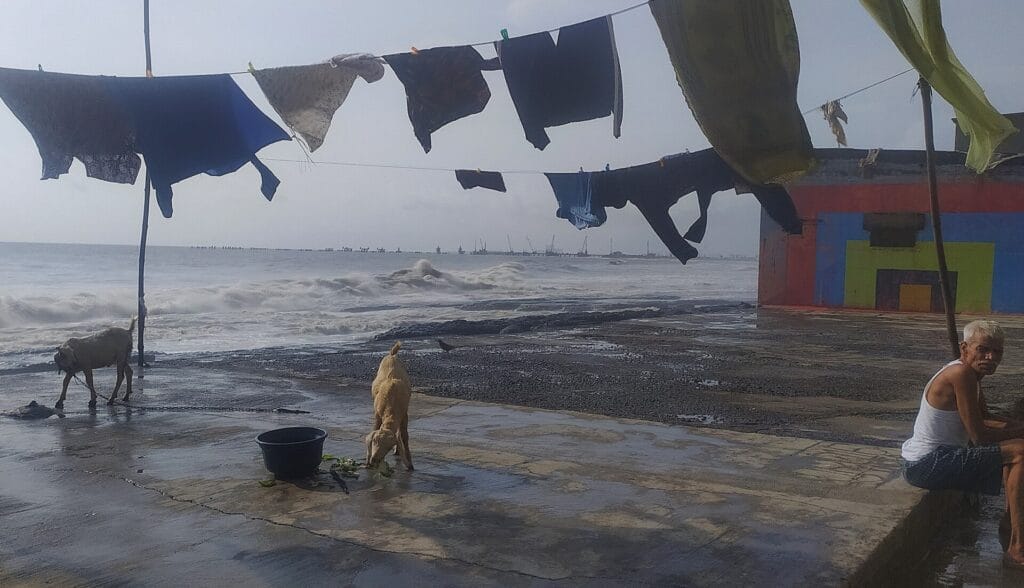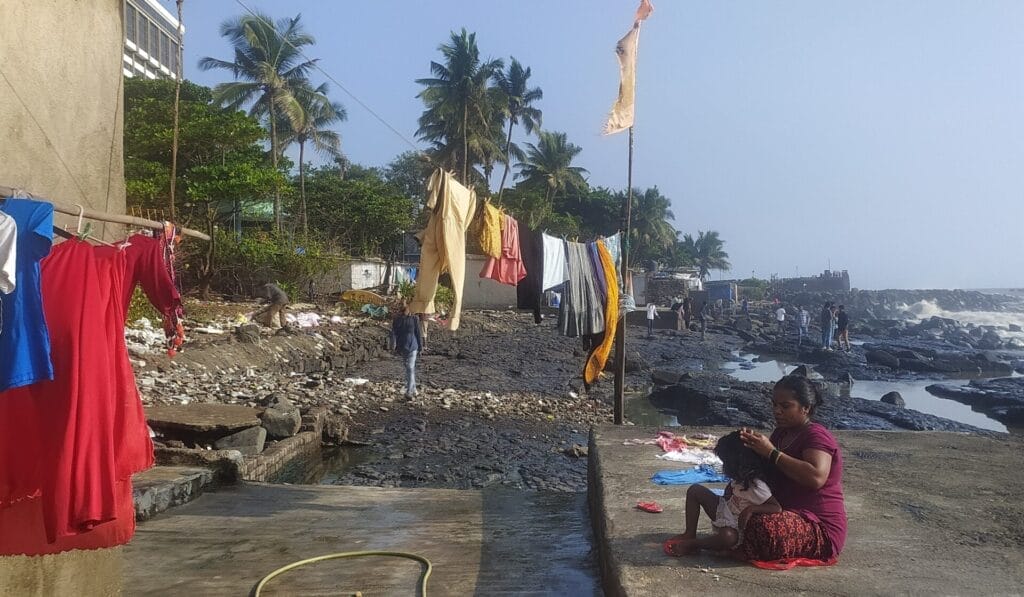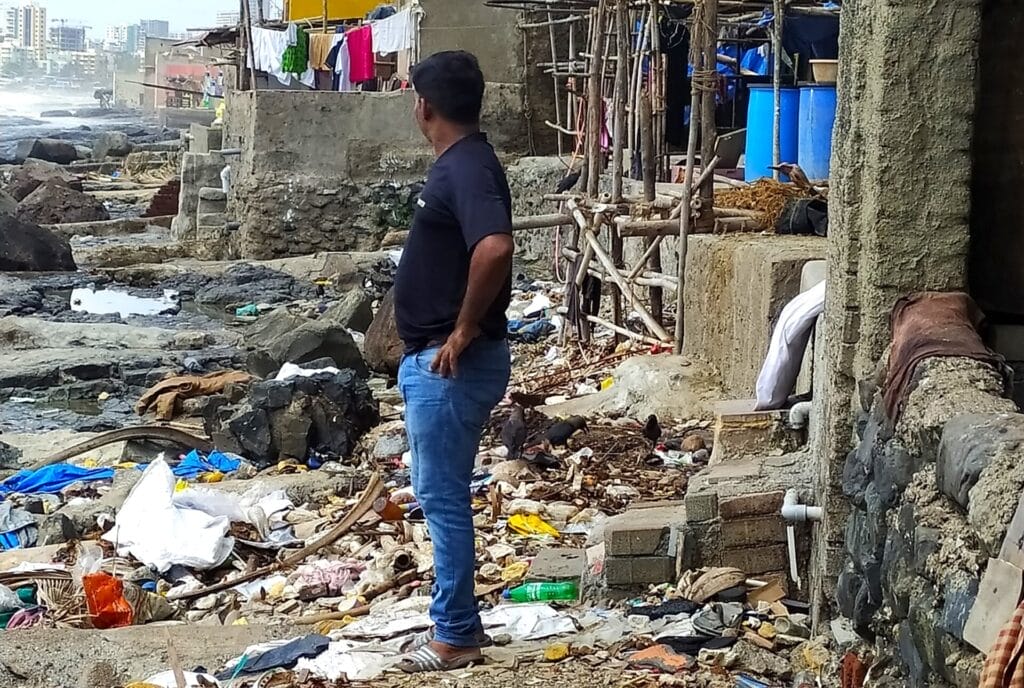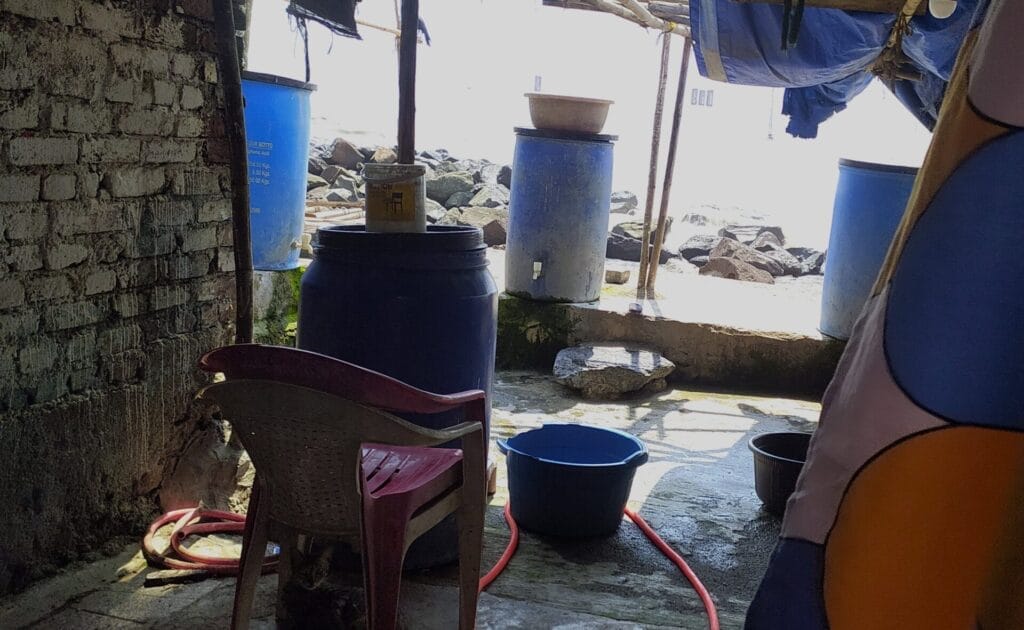As the Indian Meteorological Department (IMD) predicts an “above normal” monsoon for Mumbai, the marginalised residing in informal housing along the coastlines start anticipating and preparing for heavy rains.
Citizen Matters visited the slums of Ganesh Nagar located on the rocks of Bandstand, Bandra to explore how the marginalised communities residing close to the sea, face the challenge of rising sea levels, heavy floods during the monsoons, worsened by climate change.
Proximity to the high tidal waves — some of them have waves lashing right into their doors during the high tides — impacts their daily living. For the residents here, the sea is an integral part of their lives and they have learnt to live with it and its varied moods.
Preparing for monsoon, for decades
Mewalal Nirmal, who irons clothes for a living, has been residing at Ganesh Nagar for over 23 years. He says that the families have built cement platforms over the rocks to cut the intensity of the waves lashing onto their houses.

“These cement platforms were built around January 2016 over a depression between rocks. They protect us and are also used as a common space by residents to interact with each other. At times, youngsters sleep here. I spent over Rs 80,000 and each of our neighbours contributed for building the slabs in front of their house,” says Mewalal. He also puts up wooden pieces on the lane leading to his house during high tides to prevent the sea water from entering.
He says the residents now have the option of waiting at a higher common spaces till the tidal waters reduce in a few hours. He has witnessed tidal waters reach waist level in his house earlier, but now they simply move to the loft or upper deck of the house.
Pratima Devi’s house is nearest to the sea, at the end of the settlement. She is probably the most vulnerable having two small daughters, aged 9 and 3. However, her solutions are quite practical. Close doors and stay indoors during high tides and wait till the waves are done lashing on her doors. Keep important things such as valuables and documents on a higher level.

“We keep tabs on the tides, the seasons and also whether it is a full moon day (Poornima) or no moon day (Amavasya),” she says. She keeps an eye on whether the waves are the ones pushing out (most of them in Bandstand are, she says) or the ones, which pull you inside the waters.
Her children love the waters and get excited when the waters rise. Her neighbours come out together during high tides and check on each other.
Wilson D’Souza, 42, doubles up as a lifeguard, a four-wheeler mechanic, a flex banner designer, a masseur and even an auto-rickshaw driver. He says he was brought up in this locality and knows the rocks, the winds and the waves really well.

His house being on a slightly higher level doesn’t get flooded nor did he have to bother having to shift things. “There is a huge rock just ahead of our area that breaks down the strong waves lashing down at us and thus serves as a protection for us. This protects houses in our area from strong waves hitting us,” he says.
Oldest resident’s memories of monsoon
Jagpati Babulal Nirmal, is probably one of the oldest residents of Ganesh Nagar, she prefers calling it only as Bandstand. Most of the original residents worked as dhobis or washermen, who washed clothes and put them out on the rocks for drying. The vagaries of monsoons only meant that clothes took time to dry during this season. Beyond that most of the residents feel quite comfortable here.
She sits across on a chair, overseeing her daughter-in-law washing the vessels and her great-granddaughter playing around even as the waves lash a distance away. “I must be over 60 years old,” she says adding that she has been staying there for over 50 years.

Between the waves and her house, lie rocks with waste in the form of plastic bottles and garbage. Scooters move in the narrow alleys lined with plastic pipes carrying drinking water from community water taps.
She recalls the time when the authorities would demolish their huts and take away their belongings. “We have lived in houses made of cloth sheds. Our children have slept in hot sunlight, during those difficult times. Thankfully, the demolitions have reduced. So, we are able to have brick walls now.”

“Earlier, we would put up plastic sheets over the roofs to avoid leakages. We did put tar once over our roofs, but it didn’t work well. We now do a round of cementing on the roofs to plug the gaps and that works well,” says Jagpati.
“We understand the waters, the darkening clouds and can guess how it plays out,” she recalls. Besides, the high tides come only during the day and not during the night. So, we feel quite safe sleeping at night.”
Monsoon is different for visitors and residents
A common refrain is that it is always the outsiders or the visitors who get drowned and are rescued by the local residents. Several incidents of drowning have happened, especially with the youngsters busy with taking selfies or making reels.
Wilson “We dive in to save if some visitor drowns in the water and try to bring them out. At times, we get hurt while rescuing them from the strong waves lashing on the rocks but the government refuses to pay us or even acknowledge our efforts,” says Wilson. Such incidents are a regular occurrence during the monsoons but the authorities refuse to have a proper lifeguard system in place, he rues.
Sapna Rai says the children here know swimming and are quite comfortable with the waters. In fact, if at all, the government must rein in visitors, especially the couples, who don’t understand the nature of the sea waters and tend to endanger their lives,” says Sapna, who stays on rent in the locality.
Read more: As monsoon intensifies, fear grips citizens living on the banks of Poisar river
Does monsoon necessitate evacuation?
Leelavati Guruprasad says that this area is quite safe and its unfair to drum up fear by the authorities. “In all the 50 years that I have been residing here, we have had to be evacuated from here only once during emergencies,” she recalls. Even then she blames the authorities for scaring them off. “It just turned out to be a false alarm,” says Leelavati.
“The only precaution we take, when the water levels rise, is to shift out our important papers and things to our relatives houses elsewhere,” she says.

The house of SK Shreshta, is the last in the area, located on the rocks. Shreshta, who works
as a security personnel in a city college, has raised his house a little higher. It prevents the
waters from entering his house even during the high tide.

Local ex-corporator Asif Zakaria though feels that mere exhortation for the people to step out of their houses during climate emergencies, doesn’t work.
“It doesn’t work that smoothly. Residents are reluctant and refuse to shift elsewhere, assuming it would be be safe. So, the police are also involved. They cordon off the area for residents and get them to the temporary shelters set up in local neighbourhood schools,” says Zakaria, who was involved with relief operations.
While living with the sea, monsoon is part of life
For Neha Suraj Singh, who shifted to Mumbai from Patna two years since her marriage, living right on the coastline is a new learning experience.
“I got pushed down by the high tide when I had stepped out to visit the toilet. My family pulled me back home to safety. I lost my anklet and was in no frame of mind to search for it. Thankfully, my neighbour found it for me. I am getting used to all this,” she says cheerfully. Her family always offers food to the sea as a practice before eating.
Anita Roy, 36, who has been living at Bandra Bandstand since she was nine years old, says that the people have got friendly with the sea and learnt to live with it.

Being close to the sea only meant keeping a closer eye on her son, when he was younger.
She says that they were forcibly evacuated by authorities and shifted to neighbouring schools during Tauktae cyclone. This is the only time they had to leave their houses in all these years.
“The sea is an integral part of the our lives. We cannot stop going to work because of the high tides and waves. Actually, the sea is turbulent only for a few days. Otherwise, rest of the year everything is fine.”